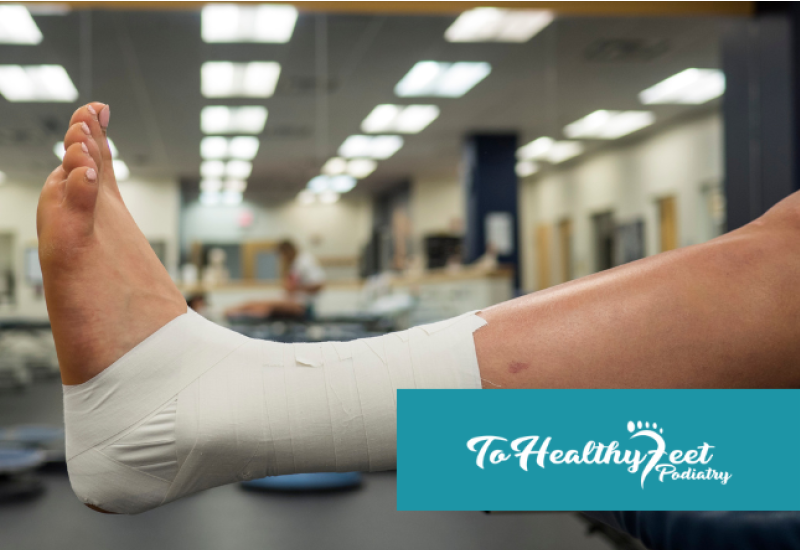Have you recently sprained or rolled your ankle and are looking for what you can do to help it heal? You’ve come to the right place! Here is our guide on recovery from an ankle sprain with tips and advice from our expert foot doctors.
A sprained ankle can vary from being a minor inconvenience to a serious injury that will require months of rehabilitation. In the immediate aftermath of the accident, you may feel at a loss of what to do. This is where we can help. This article has tips for both mild and severe ankle sprains so that you can start feeling better quickly. While you could disregard some of the advice that follows, doing so can put you at a greater risk of some long-term consequences, including:
- Chronic instability
- Development of secondary foot and ankle issues
- Stress fractures
- Greater likelihood of repeat ankle sprains
To avoid these, keep reading our guide to ankle sprain recovery.
Get Your Ankle Sprain Healed At Our Manhattan Foot Clinic
No matter how mild you believe your ankle sprain to be, you shouldn’t leave your health up to chance. At To Healthy Feet Podiatry, our team of experienced foot doctors can diagnose and treat your ankle sprain along with many other foot conditions such as foot fractures, tendon injuries, and tendonitis.
Get yourself walking tall again and book your appointment online or call our clinic at 917-398-3668 today!
How Bad is the Sprain?
While you won’t be able to diagnose the particular grade of your sprain without the help of an NYC podiatrist, you can assess your pain and mobility level to decide how much action needs to be taken. If your pain is minor, your ankle feels stable, and you have plenty of range of motion, you likely have a mild, grade 1 ankle sprain. For these ankle sprains, a couple of days of rest should do the trick to get you feeling better. However, if any of the above symptoms are anything more than minor, be sure to see a qualified foot and ankle specialist to get an accurate diagnosis and proper treatment.
What Immediate Treatments Can I Do?
Regardless of the severity of the sprain, you should immediately begin the recovery process so that you aren’t injured for any longer than you need to be. Waiting for treatment could cause increased swelling, torn ligaments, possible broken bones and put you at greater risk of chronic ankle instability. Here are some therapy methods you can use while you wait for your appointment with a Manhattan foot doctor:
RICE: This acronym stands for rest, ice, compression, and elevation, and should be used for any grade of an ankle sprain.
- Rest your ankle by limiting walking or moving around.
- Ice your ankle to help alleviate the swelling.
- Compress your ankle with a tensor band or tape to help reduce swelling (don’t compress so tight that it is painful).
- Elevate your foot to improve circulation, so more oxygen and nutrients get to your ankle
OTC Painkillers: While they won't be as potent or effective as the kind your podiatrist will prescribe to you, OTC painkillers can help with pain mitigation in the meantime before your appointment.
Heat: While it may seem counterintuitive to have both ice and heat, they can each be used effectively. While heat is not something you want to use while swelling is present, it is quite useful in stimulating healing once the swelling has gone down.
Stretch and Gradual Exercise: Stretching is an excellent way to promote blood flow to the area while also subtly strengthening the muscles and ligaments to help prevent sprained ankles in the future. Gentle exercise is also effective at encouraging blood flow and strengthening the muscles. Be sure not to overdo it too quickly, though!
What Will My Podiatrist Recommend?
While the specific treatments you will be recommended will differ, there are some popular methods that bear mentioning, such as:
NSAIDs: Also known as nonsteroidal anti-inflammatory drugs, these are prescription medications that your podiatrist may recommend to reduce swelling and pain.
Bracing or Cast: If your foot doctor determines that your ankle is unstable, they may recommend temporary stability inducing measures such as a brace, cast, or walking boot, to alleviate pressure from your ankle and promote healing.
Physical Therapy: While physical therapy will not do much to help heal your current injury, it will do wonders for strengthening and preventing chronic pain and repeated ankle sprains.
Surgery: This course of action is only recommended for severe ankle sprains. If your sprain involved torn ligaments and other structural damage, surgery might be the optimal recovery method, resulting in a lengthy recovery time.
How Long Will It Take To Heal?
Due to the complexity and frequency of sprained ankles, the recovery period can vary greatly. If you merely rolled your ankle, it may only take a day or two to feel 100%. However, if you have a grade three ankle sprain meaning you have completely torn ligaments and other damage, it may take many months to recover.
While one of the most important parts of healing is strengthening with exercise, be sure to add this in gradually over time. If your sprain is minor, you can begin some casual activity right away. But if your sprain is more serious, you may want to have an NYC podiatrist's clearance before engaging in physical activity.
Related Articles:
- Broken Vs. Sprained Ankle: How to Tell the Difference and What To Do
- Stop Spraining your Ankles With These 6 Easy Exercises
Contact Our NYC Foot Clinic For Any Degree of Ankle Sprain
If you have hurt your ankle in any way, you shouldn’t be putting your long-term health at risk. Contact To Healthy Feet and take guessing out of your health. We will provide accurate diagnosis and effective treatment for all degrees of ankle sprains.
To schedule your appointment, call us at 917-398-3668, fill in our contact form below, or book your appointment online!
FAQ’s
Q: Will walking gently on my sprained ankle make it better?
Immediately after the incident, you should not walk on your sprained ankle. Resting it before gradually reintroducing exercise will help strengthen the ankle and prevent any further damage to your foot.
Q: What are the differences between grades of ankle sprains?
There are three degrees of ankle sprains:
- Grade 1: One or a couple of ligaments have been stretched and strained, leading to mild pain, stiffness, and swelling. You should be able to walk with only minor discomfort.
- Grade 2: One or more of your ankle ligaments have been partially but not completely torn. Although you may be somewhat stable, it can be incredibly painful to touch and put weight on.
- Grade 3: There has been at least one ligament that has been completely torn, resulting in instability, inability to walk, severe swelling, bruising, and redness, as well as excruciating pain.
Q: What does it mean if I hear a ‘pop’ when I sprain my ankle?
This likely means that a ligament has been torn or a bone has been broken. Please see a doctor immediately if this is the case.



